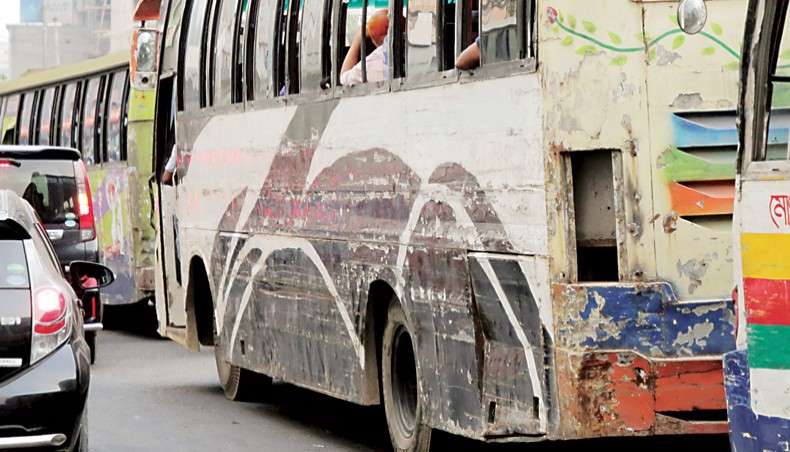Buses with dented bodies lumber along city roads
Dhaka city buses and minibuses, with their bodies carrying innumerable dents and their paints gone long since, are still running as the owners turn a deaf ear to the repeated directives of the authorities for making these pleasing to the sight.
Every year Bangladesh Road Transport Authority requests the bus operators to repair these buses and minibuses as these vehicles are now very ugly to look at and this bad look is responsible for much of the desperation the drivers demonstrate while driving.
But the transport owners seem not to give a damn to the requests.
Dhaka Metropolitan Police commissioner Md Aasaduzzaman Mia on September 30, the last day of a month-long special traffic programme, said that all their efforts to enforce traffic rules failed due to people’s tendency not to obey the law.
Now, BRTA faces the same situation.
Experts on urban planning and public transport system point out that when the government vehicles and organisations will follow the directives, all private vehicle owners will be compelled to follow them.
All rule violators whoever they are should be held accountable, they recommend.
In September this year, BRTA published a release in newspapers asking the owners to make these vehicles pleasant to the eye and suitable by September 30 or legal action would be taken.
The authorities on September 25, 2017 published the same urgent release in newspapers to complete repair of buses by November 26.
The High Court on August 3, 2015 asked the government and the police to keep unfit motor vehicles off the roads across the country.
Road transport and bridges minister Obaidul Quader on October 22, 2017 at a discussion said many vehicles with such ‘poor’ look, now operating in the city, would
not be seen in small towns and even in rural areas.
Claiming that Bangladesh was a model of development, he said, ‘But you are making Bangladesh ashamed as foreigners often point at traffic congestion and unfit vehicles.’
Now, defying all these directives and warnings, old rickety buses including those of Bangladesh Road Transport Corporation are running on all major city roads.
Companies including Anabil Super, Salsabil, Raida Seating service, Suprovat Special Service, Akik, Shatabdi, Great Turag, VIP service, Paristhan, Projapoti, Nur-e-Mokka and Osim transports are operating their buses with innumerable dents and almost no paints on their bodies.
The commuters, moreover, allege that the number of public buses and minibuses has fallen in the recent times.
It is a common scene that whenever any directive is given against buses, the owners take their buses off the street for avoiding legal action, they say.
‘These buses have new painting on their bodies but these paintings are of low quality. So what is the use of using these paints,’ says Abrar Hossain, a Kalabagan resident.
‘From my experience in operating mobile courts, I can say that some buses get new look while a huge number do not comply with the directive,’ says a BRTA executive magistrate seeking anonymity.
Besides commuters, some executive magistrates of BRTA have also admitted that in recent times the number of buses on roads has reduced.
‘If BRTC vehicles run with dented bodies, why will private owners paint their vehicles?’ asked Mubasshar Hussian, an urban planner and former president of Institute of Architects Bangladesh.
Mubasshar said that if government organisations and the ruling party would become law abiding, the law enforcers would be able to enforce law strictly.
Public transport expert SM Saleh Uddin said the tendency of not following law would not improve in a day as the problem was very old.
He, also a former executive director of the then Dhaka Transport Coordination Board, alleged that an influential quarter was playing hide and seek by taking off buses from streets whenever the government told them to paint their vehicles.
‘The authorities which have been tasked with the work should be held accountable,’ he added.
Dhaka Road Transport Owners Association president Abul Kalam claimed that most of the buses got their bodies painted but asked, ‘Is it possible to paint all 5,000 buses within a month?’
He blamed lack of workshops, manpower and raining for the slow the process of painting the buses.
Within a few days all buses would be painted as per the directive, he said.
About the quality of bus paint, Kalam said that it would cost Tk 70,000 to paint a bus with original colour and it was impossible for the owners to spend so much for a bus.
In most cases the buses themselves did not cost as Tk 70,000, he claimed, arguing that an owner in the capital would not be able to earn the amount in four months.
Dhaka Metropolitan Police joint commissioner for traffic (south) Mofiz Uddin Ahmed told New Age that they usually prosecuted a bus if it did not have fitness and its body was in a bad condition.
‘Sometimes we request the owners to repair their buses and sometimes we compel the owners for the act,’ he said.
BRTA director (enforcement) Nur Mohammad Mazumder told New Age that currently their seven executive magistrates were operating mobile courts and taking legal action against the owners of dented buses after the deadline.
He said no one complained to him about few buses on city roads.
BRTA magistrates said that they usually prosecute dented buses under the Motor Vehicles Ordinance 1983’s section 140 and section 152 while the fines ranged usually between Tk 500 and Tk 3,000 which could be increased based on situation.
News Courtesy: www.newagebd.net











